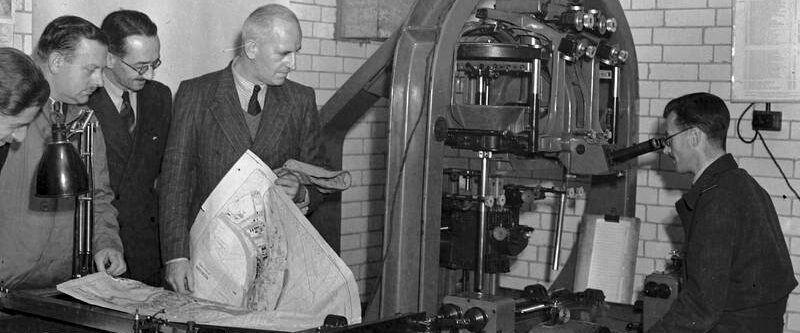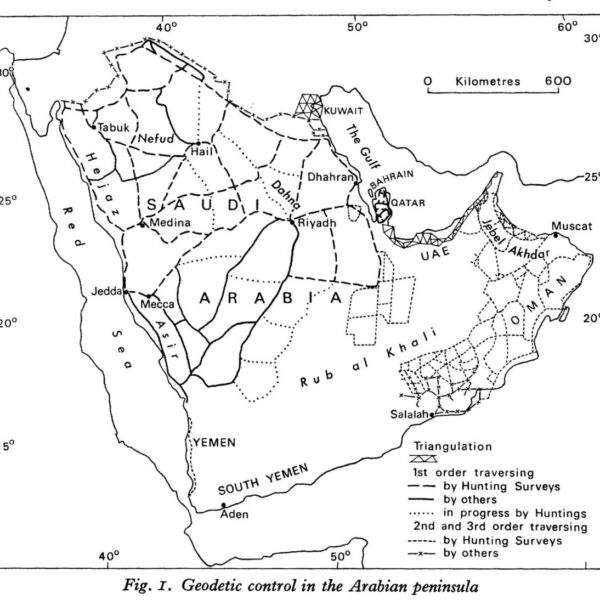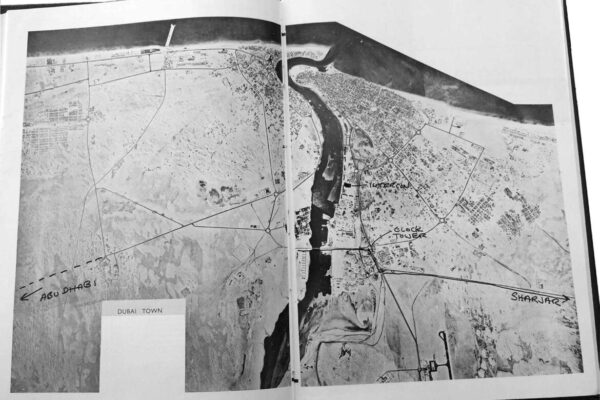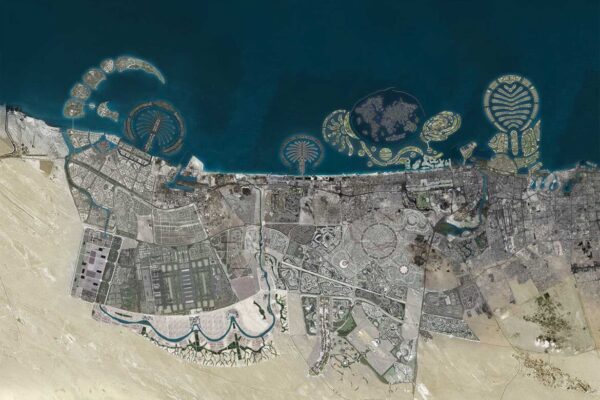Sixty-one years ago this week, an airplane made flights over Dubai. A specially built aerial camera, mounted to the plane’s floor and aimed at Earth below, zoomed in to capture every knot of a sandbar in Dubai Creek, every palm on every farm, and every courtyard of every coral house; it could sense the faintest of trails from 3,600 meters high. Weeks passed before the film made it to the offices of Hunting Surveys in southern Hertfordshire. There, technicians submitted the images to photogrammetry—warping and stretching them to agree with on-the-ground recorded distances. The result was “a synoptic view of the ground.” Dubai’s hustle, normally played out daily and unpredictably in three dimensions, was now clamped down, silent, in two dimensions.
The survey—an “aerotriangulation and mapping at 1/2000 scale by precise photogrammetric methods”—marked an uncannily legible datum. From it, Dubai would be measured. It was the most accurate recording of Dubai, but it was months out of date before anyone saw it. Perhaps as late as April, the architect John Harris received his copy, on top of which his office drew Dubai’s first town plan.
It won’t surprise anyone that the aerial imaging company Hunting Surveys came about from a swirl of architecture, military strategy, and the entertainment industry. Co-founder Francis Wills was educated as an architect, his earned skills leading to his assignment to photographic surveillance during World War I. After the war, he didn’t return to architecture; instead, he invested his wartime contribution in the filmmaking business, to shoot aerial scenes for movie productions. (He’s on the left in this image.) In 1938, in an effort to expand the company’s services, Wills traveled to Switzerland to purchase a Wild Heerbrugg A5 stereoautograph.
It wasn’t long before his big, expensive Swiss machine got drafted for World War II service and proved its value by identifying, accurately enough, the location of German missile launch sites. In the image above, the Wild A5 is at work at a Royal Air Force site. The seated man is peering through not only the magnifying lenses of a microscope, but also other lenses designed to negate various sorts of visual distortion. Distortion to counter distortion. In some mechanical way, the technician could order the stereoplotter, to his left, to “trace” what he saw through the viewer.
Mapping Dubai constituted sequences of distancing: without seeing Dubai or even touching the final sheet of paper, a technician processed altitudinal views through long-form mathematical equations—all done to instruct a mechanical arm to draft an impossible, godlike view.
It is easy to associate aerial photography, and photogrammetry, with omniscient control. In fact, the word control appears, on its own, in their everyday practice. Analysts seek “horizontal control,” “azimuth control,” “vertical control,” “total control,” and a “control network” imagined to blanket the planet. Francis Wills’s colleagues called him Daddy.
Dubai came under such control when aerial photographs still depended on geographical triangulation completed by an army of engineers, footmen, cooks, administrators, and beasts of burden who moved across a targeted landscape to prepare it for photographing. Not unlike the ancient Greeks with their gnomons, and the ancient Egyptians who erected obelisks to measure the relation between the stars and the Nile, a grid of pipes (“driven into the dune to a depth of 10 m, or until refusal”) had to be planted. “The difference is in accuracy,” is the way a Hunting surveyor distinguished his work from that of the ancients. Another difference: Hunting’s explicit ambition to control the planet. Geodetic control, it was called.



